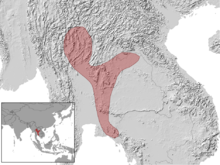| Banded supple skink | |
|---|---|
| Conservation status | |
 Least Concern (IUCN 3.1) | |
| Scientific classification | |
| Domain: | Eukaryota |
| Kingdom: | Animalia |
| Phylum: | Chordata |
| Class: | Reptilia |
| Order: | Squamata |
| Family: | Scincidae |
| Genus: | Lygosoma |
| Species: | L. haroldyoungi |
| Binomial name | |
| Lygosoma haroldyoungi (Taylor, 1962) | |

| |
| Geographic range of Lygosoma haroldyoungi in Southeast Asia. | |
| Synonyms | |
| |
The banded supple skink (Lygosoma haroldyoungi), also known commonly as Harold's writhing skink and Harold Young's supple skink, is a species of lizard in the family Scincidae. The species is endemic to Southeast Asia.
Etymology
The specific name, haroldyoungi, is in honor of American missionary Harold Young, who worked in Burma (now Myanmar) and Thailand, and founded the Chiang Mai Zoo.
Distribution
L. haroldyoungi is distributed in northern, central, and eastern Thailand and neighbouring Laos (Moravec and Böhme 2008). In Thailand it has been found in the provinces of Chachoengsao, Chaiyaphum, Chanthaburi, Chiang Mai, Chiang Rai, Nong Khai, Phetchabun, Phitsanulok, Nakhon Ratchasima, and Loei. In Laos it occurs in Vientiane Province, and it is also found in Myanmar.
Habitat
L. haroldyoungi is found in tropical deciduous forest and cultivated areas, at altitudes of 100–500 m (330–1,640 ft).
Description
As an adult, L. haroldyoungi has a snout-to-vent length (SVL) of 11.5–14.8 cm (4.5–5.8 in). It has four legs, all of which are very short.
Diet
L. haroldyoungi preys upon earthworms and insects.
Reproduction
The mode of reproduction of L. haroldyoungi is unknown.
Conservation status
L. haroldyoungi is threatened by habitat loss, but this is not a significant threat as it survives in agricultural areas.
References
- ^ Sumontha, M.; Phimmachak, S.; Cota, M.; Panitvong, N.; Stuart, B.L. (2018). "Lygosoma haroldyoungi ". IUCN Red List of Threatened Species. 2018: e.T12471A112848672. doi:10.2305/IUCN.UK.2018-2.RLTS.T12471A112848672.en. Retrieved 17 November 2021.
- ^ Species Lygosoma haroldyoungi at The Reptile Database www.reptile-database.org.
- ^ Beolens, Bo; Watkins, Michael; Grayson, Michael (2011). The Eponym Dictionary of Reptiles. Baltimore: Johns Hopkins University Press. xiii + 296 pp. ISBN 978-1-4214-0135-5. (Lygosoma haroldyoungi, pp. 116-117).
Further reading
- Chan-ard T, Parr JWK, Nabhitabhata J (2015). A Field Guide to the Reptiles of Thailand. New York: Oxford University Press. 352 pp. ISBN 978-0-19-973649-2 (hardcover), ISBN 978-0-19-973650-8 (paperback).
- Geissler P, Hartmann T, Neang T (2012). "A new species of the genus Lygosoma Hardwicke & Gray, 1827 (Squamata: Scincidae) from northeastern Cambodia, with an updated identification key to the genus Lygosoma in mainland Southeast Asia". Zootaxa 3190: 56–68.
- Moravec J, Böhme W (2008). "First record of Riopa haroldyoungi from Laos". Herpetological Notes 1: 9–10.
- Taylor EH (1962). "New Oriental Reptiles". University of Kansas Science Bulletin 43 (7): 209–263. (Riopa haroldyoungi, new species, pp. 242–244, Figure 12).
| Taxon identifiers | |
|---|---|
| Lygosoma haroldyoungi | |
This Lygosominae article is a stub. You can help Misplaced Pages by expanding it. |